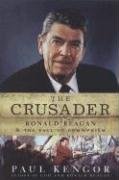The author, Paul Kengor, PhD., succeeds at laying out President Reagans lifelong battle (his crusade) against communism. The book has a linear flow of events, beginning with Reagans lifeguarding days at his beloved Lowell Park in Dixon, Illinois and then arriving at his nadir as the driving force behind the eventual collapse of the USSR.
Ronald Reagans actions against communist infiltration of Hollywood while president of the Screen Actors Guild is discussed, along with his testimony before Congress during the Red Scare craze that erupted during the 1950s. The governorship of California is discussed briefly, and serves as a nice transition into the 1976 candidacy and the eventual platform that led to success in 1980.
As any president is only as effective as the administration members surrounding him, Dr. Kengor includes details and perspectives from key figures inside the CIA, NSC, and other agencies, foreign and domestic (including the late pontiff John Paul), that helped speed along the presidents goal of stemming the growth of communism.
Thorough attention is given to the administrations efforts to aid the Afghan and Polish people after their demise brought about the Soviets.The subject of Iran-Contra is discussed with candor, but in perspective of the administrations goals behind the affair. Also treated is the invasion of Grenada, a move that earned the administration scorn and praise, and that Reagan credited with reversing the negative feelings Americas uniformed personnel had harbored since the Carter Administration and the failed Desert One operation.
The book is an outstanding survey of President Reagans battle against communism (the USSR, specifically) and as such only briefly covers many other facets of the Reagan administration. Readers seeking in-depth information beyond Reagans success at eradicating communism should look elsewhere.
Ronald Reagans actions against communist infiltration of Hollywood while president of the Screen Actors Guild is discussed, along with his testimony before Congress during the Red Scare craze that erupted during the 1950s. The governorship of California is discussed briefly, and serves as a nice transition into the 1976 candidacy and the eventual platform that led to success in 1980.
As any president is only as effective as the administration members surrounding him, Dr. Kengor includes details and perspectives from key figures inside the CIA, NSC, and other agencies, foreign and domestic (including the late pontiff John Paul), that helped speed along the presidents goal of stemming the growth of communism.
Thorough attention is given to the administrations efforts to aid the Afghan and Polish people after their demise brought about the Soviets.The subject of Iran-Contra is discussed with candor, but in perspective of the administrations goals behind the affair. Also treated is the invasion of Grenada, a move that earned the administration scorn and praise, and that Reagan credited with reversing the negative feelings Americas uniformed personnel had harbored since the Carter Administration and the failed Desert One operation.
The book is an outstanding survey of President Reagans battle against communism (the USSR, specifically) and as such only briefly covers many other facets of the Reagan administration. Readers seeking in-depth information beyond Reagans success at eradicating communism should look elsewhere.




